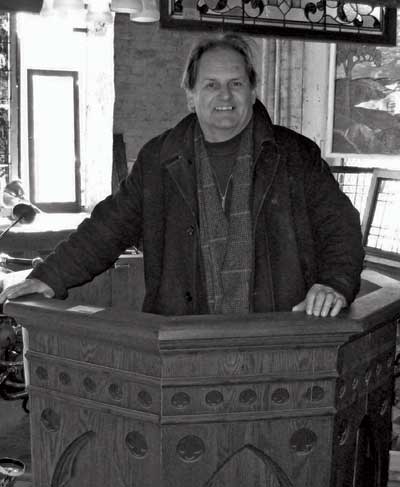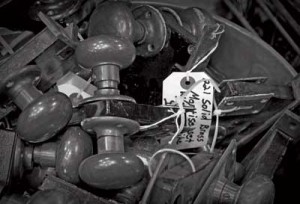Small Home Gazette, Spring 2009
Old Wine, New Bottle:
Architectural Salvage Helps Buildings Live On
An interview with John Eckley, owner of City Salvage in Minneapolis
For over 35 years, John Eckley has been involved in businesses that preserve architectural elements even when their original context is no longer viable. His interest in salvage has influenced the business not only in Minnesota but also around the United States. As John explains in this interview, the salvage process can often be more art than science with definite challenges but the thrill of the treasure hunt remains. And like all businesses, there have been many changes over the decades including those introduced recently by the decline in our economy and the increase in sustainability and reuse.
 Small Home Gazette: How did you get interested in architectural reuse and salvage?
Small Home Gazette: How did you get interested in architectural reuse and salvage?
John Eckley: I have always been interested in history, especially related to architectural styles. My mom owned a gift shop in Minneapolis at one time called “The Yesterday Shop,” and we were always looking for antiques and other items to include in the shop. This started my interest in home restoration.
SHG: How did you get started in the salvage business?
Eckley: I grew up in Chicago and had an interest in glasswork and art glass in particular. While I was a student at the University of Minnesota in the mid-70’s studying architecture, I worked part-time for Kathy Koskey and Diane Fliss who owned a prop company called Scroungers. This was my first introduction to the salvage business. After working with Kathy and Diane, we, along with Barbara Harrison, formed Architectural Antiques. I opened City Salvage 13 years ago so, after 35 years, I’m still actively involved in architectural reuse. I estimate that my companies have influenced many salvage companies around the country in the past 30 years.
SHG: How do you identify salvage opportunities?
Eckley: For me, the thrill of this business is the hunt for treasure. I have established great contacts over the years that let me know about possible demolitions. There really is an “inner circle” of people involved in this business, and we all know each other. The Internet has made a huge difference in how this business works. Everyday, I spend time responding to queries that come through our website and phone calls. We look for opportunities anywhere in the U.S.
One recent and very welcome change is that the city of Minneapolis is interested in working with us before a building is demolished—especially in the case of foreclosure. This is great because it will save the city money since it reduces the total demolition cost and keeps items out of a landfill.
Once I identify an opportunity and the available salvage items, I’ll make a bid based on my experience and knowledge of the resale value for the items. Nothing is available for free. We don’t go to auctions since the prices tend to be inflated due to emotional bidding.
SHG: What is the process for obtaining the salvaged items?
Eckley: I have a crew of independent people who really enjoy the process of removing these architectural elements. I’ve been working with the same crew of 3 to 12 people for years. Sometimes we have as little as 24 hours to remove the items prior to demolition so it helps to have an experienced group of people to call on with short notice and who are willing to work the long hours often required to meet a demolition deadline. In many cases, we also need to bring our own infrastructure meaning electricity, heat, etc., since much of that infrastructure can already be gone by the time we get there.
 SHG: What do your customers expect related to the authentication of items? Do they expect you and your staff to be history and architecture experts?
SHG: What do your customers expect related to the authentication of items? Do they expect you and your staff to be history and architecture experts?
Eckley: We do our best to know the origin of what we sell. Experience is really key, and we are continually learning from and teaching each other. If we haven’t salvaged the item ourselves, the source is another dealer we already know who can tell us about the item. If I know the history, it’s easier to make the sale; people really do appreciate the story. Unfortunately, huge amounts of product are actually sold without questions. The buyer is only interested in the visual appearance and the dimensions. That can be disappointing but that’s how it is.
SHG: What was the most exciting project you ever worked on?
Eckley: That would be the Andrew-Riverside Presbyterian Church in southeast Minneapolis that was demolished in 2003. That church was designed by architect Charles S. Sedwick and built in the late 1800s with limestone dating to 1878. This was a great project due the scope of it. We removed huge stained glass windows and even the bell from the bell tower. There are quite a few stories about all the effort it took to get everything out of there.
SHG: What is the impact of the “green” and sustainability movement on architectural reuse?
Eckley: It’s definitely having an impact. Neighborhoods are becoming more aware of the possible negative impacts of new development and figuring out that you can actually improve a neighborhood by saving the existing structures. Many of the older buildings in Minneapolis are built much better than new construction and really can’t be replaced due to a lack of similar materials like the incredible white pine timber beams used a century ago. The economy is helping preservation because it is slowing down new development that often destroys historic structures.
SHG: How has the recession impacted your business? What are some of the trends you’ve noticed in the past 12 months?
Eckley: The economy has had a very adverse effect as new construction slowed and spending on discretionary items declined. Our business tends to follow the trends in the antiques business although things have started to pick up the past four months. I am starting to see more do-it-yourself interest, however 90 percent of our business is with 30- to 50-year-olds who are interested mainly in finished pieces. I do see a resurgence of interest in the crafts, and I think the more you understand about the old production processes the more you appreciate the old things.
Unfortunately, the state of the current housing market has been a double-edged sword. There are more opportunities for salvage but often little of value is left once owners and vandals strip a property. I do get calls from homeowners looking to generate some cash by selling off things in their homes.
SHG: What is the biggest challenge for your business?
Eckley: The business needs to continually reinvent itself. The market for salvage has changed from items that buyers would restore themselves to a market demanding quality items—finished and ready to be reinstalled in a new location. There is a willingness to pay more for a certain level of quality and finished restoration. Hopefully, the throw-away society is going away. I also find that there is a lack of appreciation for the true cost of salvage. It’s not only what I pay for the items but also the cost to carefully remove those items and then restore them that has an impact on the final price. You can’t get something for free just because it looks old.
SHG: What advice would you give preservationists related to the role of architectural reuse and salvage? How would you define the relationship between salvage and historic preservation?
Eckley: We are preservationists, too, and involved in trying to save structures and find a reuse. It’s important to save and not toss something that could have another use. We share an attitude that our architectural history is important. The notion that new is better than old is rarely true if you look at building construction and the craftsmanship involved in many of these older buildings.
My final piece of advice—call us before you throw something away; everybody needs something historical in his or her life.
This article was reprinted from The Minnesota Preservationist, March–April, 2009; used with permission of the Preservation Alliance of Minnesota. Photo of John Eckley courtesy of Nicole Beckendoor; photo of doorknobs courtesy of Roger Brooks.











